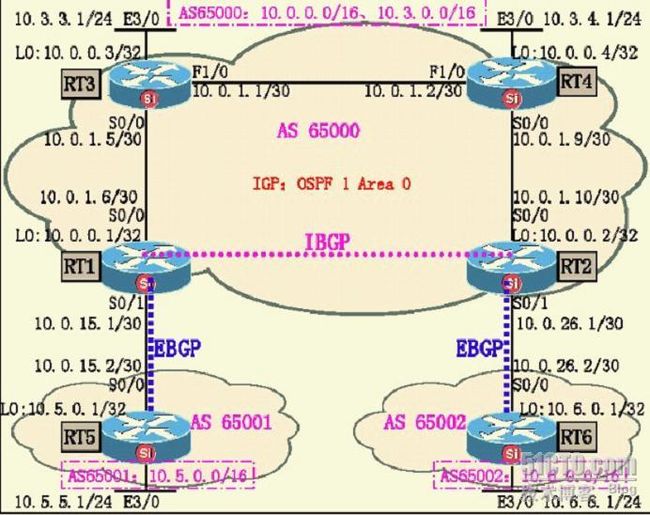组网需求:
1.AS65000边界网段发布:RT1、RT2重发布直连路由至OSPF(metric 1000 type 1)
2.BGP配置要求:
no synchronization
no auto-summary IBGP使用LOOPBACK建立邻居,下一跳指向自己
3.RT1,RT2发布AS65000的汇总路由至BGP:10.0.0.0/16、10.3.0.0/16
4.RT5发布AS65001的汇总路由至BGP:10.5.0.0/16
5.RT6发布AS65001的汇总路由至BGP:10.6.0.0/16
6.分析路由黑洞的形成及解决方法
IGP路由的配置:
R1:
router ospf 1
router-id 10.0.0.1
redistribute connected metric 1000 metric-type 1 subnets //重发布直连网络到OSPF中
passive-interface Serial0/1 //与EBGP相连的接口必须配置为被动接口,以免形成邻居
network 10.0.0.1 0.0.0.0 area 0
network 10.0.1.4 0.0.0.3 area 0
R3:
router ospf 1
router-id 10.0.0.3
passive-interface default
no passive-interface Serial0/0
no passive-interface FastEthernet1/0
network 10.0.0.3 0.0.0.0 area 0
network 10.0.1.0 0.0.0.3 area 0
network 10.0.1.4 0.0.0.3 area 0
network 10.3.3.0 0.0.0.255 area 0
interface FastEthernet1/0
ip address 10.0.1.1 255.255.255.252
ip ospf network point-to-point //配置网络类型为点对点(不需选举DR或BDR)
R4:
router ospf 1
router-id 10.0.0.4
passive-interface default
no passive-interface Serial0/0
no passive-interface FastEthernet1/0
network 10.0.0.4 0.0.0.0 area 0
network 10.0.1.0 0.0.0.3 area 0
network 10.0.1.8 0.0.0.3 area 0
network 10.3.4.0 0.0.0.255 area 0
interface FastEthernet1/0
ip address 10.0.1.1 255.255.255.252
ip ospf network point-to-point //配置网络类型为点对点(不需选举DR或BDR)
R2:
router ospf 1
router-id 10.0.0.2
redistribute connected metric 1000 metric-type 1 subnets //重发布直连网络到OSPF中
passive-interface default //与EBGP相连的接口必须配置为被动接口,以免形成邻居
no passive-interface Serial0/0
network 10.0.1.8 0.0.0.3 area 0
IBGP的配置:
R1:
router bgp 65000
no synchronization //关闭同步
neighbor 10.0.0.2 remote-as 65000 //指定IBGP邻居和AS
neighbor 10.0.0.2 update-source Loopback0 //指定更新源为LOOPBACK 0
neighbor 10.0.0.2 next-hop-self //把下跳改为自己(EBGP默认)
neighbor 10.0.15.2 remote-as 65001 //指定EBGP邻居和AS
network 10.0.0.0 mask 255.255.0.0 /静态发布路由到BGP
no auto-summary //关闭自动汇总
ip route 10.0.0.0 255.255.0.0 null 0 //添加一条静态汇总路由,用来发布
R2:
router bgp 65000
no synchronization //关闭同步
neighbor 10.0.0.1 remote-as 65000 //指定邻居和AS
neighbor 10.0.0.1 update-source Loopback0 //指定更新源为LOOPBACK 0
neighbor 10.0.0.1 next-hop-self //把下跳改为自己(EBGP默认)
neighbor 10.0.26.2 remote-as 65002 //指定EBGP邻居和AS
network 10.3.0.0 mask 255.255.0.0 /静态发布路由到BGP
no auto-summary //关闭自动汇总
ip route 10.3.0.0 255.255.0.0 null 0 //添加一条静态汇总路由,用来发布
R5:
router bgp 65001
network 10.5.0.0 mask 255.255.0.0 //静态发布路由到BGP
neighbor 10.0.15.1 remote-as 65000 //指定EBGP邻居和AS
no auto-summary //关闭自动汇总
ip route 10.5.0.0 255.255.0.0 Null0 //添加一条静态汇总路由,用来发布到BGP
R6:
router bgp 65002
no synchronization //关闭同步
network 10.6.0.0 mask 255.255.0.0 //静态发布路由到BGP
neighbor 10.0.26.1 remote-as 65000 //指定EBGP邻居和AS
no auto-summary //关闭自动汇总
ip route 10.6.0.0 255.255.0.0 Null0 //添加一条静态汇总路由,用来发布到BGP
注意:使用IBGP时默认跳数为255,EBGP的默认跳数为1,如果使用EBGP的LOOBACK地址建邻居,需手工指定跳数
neighbor 10.10.10.10 ebgp-multihop 2 //后面接的是跳数1-255
思考:现在10.5.5.1能够PING通10.6.6.1吗?
答案是不能ping通,原因是R3上没有去往R6的路由(后面分析)
现在我们来分析一下R6上的10.6.0.0/16路由的传播!
在R6上:
Network Next Hop Metric LocPrf Weight Path
*> 10.5.0.0/16 10.0.26.1 0 65000 65001 i
*> 10.6.0.0/16 0.0.0.0 0 32768 i
*表示有效 >表示最优 因为10.6.0.0是由本路由器始发所以下一跳是0.0.0.0,如果是重发布到BGP的就为IGP中的下一跳,本地始发路由的weight为32768,Originn属性为IGP
R2收到从EBGP收到的路由,向它所有的邻居转发
*> 10.6.0.0/16 10.0.26.2 0 0 65002 i
因为是由EBGP通告过来的,所以下一跳为EBGP的邻居地址
R1:
*>i10.6.0.0/16 10.0.0.2 0 100 0 65002 i
从IBGP学到的路由,是否通告给EBGP,视同步而定,因为这里是关闭同步的所以能通告给R5(如果开启了同步,必须达到同步的路由才能传给EBGP),同时在R2上配置了next-hop-self将下一跳改变为自己,所以R1收到的路由的下一跳指向它的IBGP邻居
R5:
*> 10.6.0.0/16 10.0.15.1 0 65000 65002 i
向EBGP通告路由时,将下一跳改变为自己。同理R6也能学到R5的路由
当10.5.5.1ping10.6.6.1时,R5查找路由表,匹配10.6.0.0/16的路由,下一跳为10.0.15.1为直连接口,将数发往R1,R1进行查找路由,找到匹配10.6.0.0/16路由,下一跳为10.0.0.2,不是直连接口,将下一跳为目标IP进行递归查找路由,匹配10.0..02/32的路由,下一跳为10.0.1.5为直连接口,将数据发到R3,R3以目标IP10.6.6.1进行查找路由,找不到匹配项,便丢弃数据,因为R3没有运行BGP学习不到BGP的路由,所以形成路由黑洞。
解决方法:1.将BGP的路由重分布到OSPF中
2.将AS内的路由器形成IBGP全连接
3.路由反射器
4.配置MPLS
方法1.
配置如下:
R1:
router ospf 1
redistribute bgp 65000 subnets //重分布BGP的路由到OSPF中
R2:
router ospf 1
redistribute bgp 65000 subnets //重分布BGP的路由到OSPF中
现在可以看到AS内的路由器都有AS外的路由呢,所以可以PING通了!
R3的路由表,有AS外的路由:
因为INTERNET网上的BGP路由多达十几万条,如果不做策略将BGP路由重分布到OSPF中,是不可行的,OSPF最大也只能支持一万多条路由表,并且极大消耗路由器的内存,所以此方法一般不用!
BGP路由表有14万多
方法2:
配置如下:
neighbor 10.0.0.3 update-source Loopback0
neighbor 10.0.0.4 update-source Loopback0
router bgp 65000
neighbor 10.0.0.1 update-source Loopback0
neighbor 10.0.0.4 update-source Loopback0
neighbor 10.0.0.2 update-source Loopback0
R4:
neighbor 10.0.0.1 remote-as 65000
neighbor 10.0.0.3 remote-as 65000
neighbor 10.0.0.2 remote-as 65000
no auto-summary
neighbor 10.0.0.4 update-source Loopback0
neighbor 10.0.0.3 update-source Loopback0
现在R5上测试一下:
R3收到一条路来自己R1的路由:
*>i10.5.0.0/16 10.0.0.1 0 100 0 65001 i



